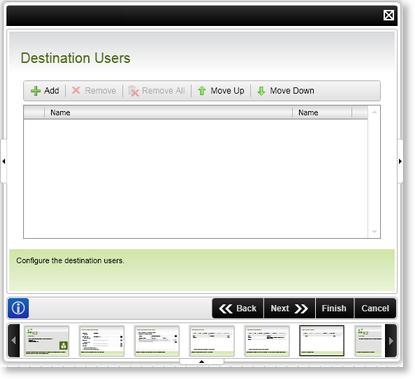Generic Wizard Screens - Destination Users
 |
How To Topic: Destination Rule Planning Scenarios |
The Destination users wizard screen identifies the role players and consumers of the Event.
 |
The Destination User is the individual or group that receives the work list item at runtime |

Fig. 1. Destination User
| Feature | What it is | How to use it |
|---|---|---|
| Add | Adds a new Destination User to the process | Click the Add button to add a Destination User to the process |
| Remove | Removes the selected Destination User from the Outcomes list | Click Remove to remove the selected Destination User from the process |
| Remove All | Removes all the Destination Users from the list | Click Remove All to remove all the Destination Users from the list |
| Name | Displays the name of the selected user or group | Display only |
| Type | Determines if the destination user is an individual or role definition | Select from the drop-down the type of user |
 |
It is best practice NOT to use the same user as destination user that is also configured as the SharePoint Farm Administrator, SharePoint System Account or the Application Pool Account. An actual User account should not be used as the SharePoint Farm Administrator, SharePoint System Account or the Application Pool Account. |
Default Behavior Change
The default behavior of client events in InfoPath Integrated processes will change from Plan Once, Create a slot for each destination, Create a slot for each role and group to Plan Once, Specify the number of slots to be created=1, Create a slot for each role and group. in order to be consistent with all other client events. This behavior will only be implemented when a new InfoPath Client Event is dragged onto the design canvas. All existing processes will not be affected when upgrading.
See Also
